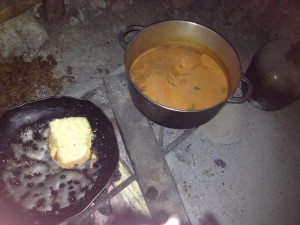One of my favorite things about traveling is cooking, and well… eating. I noticed this, or rather my host mother noted this fact when photo after photo I showed her contained either nature, mainly the Pacific Ocean, surfboards, my family, or well, food. “Laura, I can tell you really like making food!” she laughed. Or maybe it’s the eating of it that’s more appealing? Truth be told, I’m mainly obsessed with anything with cheese, which would explain the grilled cheese and tomato soup I prepared, or the mac ‘n’ cheese attempt of last week.
But this blog entry isn’t really about cheese. The more time I’ve spent in Cameroon, the more I’ve come to appreciate the local cuisine, and its nuances. And especially these past few days, I’ve come to admire the manioc, also cassava, or a type of yucca. Mainly this happened when my host mom started turning our kitchen into a manioc factory for the Japanese organization she’s working for, so I was able to appreciate the entire process. What I came to realize is how important cassava is in the diet of the majority of Cameroonians, and how they have come up with as many different ways of cooking and preparing it, to make it taste…well, like something. Unfortunately it is not nutrient rich, and alone does not provide the needed vitamins and minerals to have a healthy lifestyle. Nevertheless due to its availability, it’s as widespread as potatoes or wheat is in the U.S.
First, the trick is to go collect this tuber that looks kind of like a yam or long potato, which involves heading out to the fields, where they grow plentifully as one of the easiest and cheapest crops to grow in Sub-saharan Africa. Once gathered, you have to peel off the bark-like skin, to get to the white center. One day I came home to a kitchen covered in peelings, as the boys and local teens worked with their machetes and large knives to cut through a massive amount of manioc. Often at this point people cook the tuber, dousing it in sauce or anything to give it some flavor, which in my opinion it rather lacks.
Next, my host mother placed all of the veggies, freshly peeled into massive vats of water, to ferment over the next few days. Once fermented you could see a bubbly, white film on the top of the buckets, signaling they were ready. Then she showed me how at this point they were squishy, almost claylike, and ready to be dried into flour. I watched fascinated as she crumbled the manioc in her hands and tossed it onto a tarp outside to dry. Once dried it became a flour that could make “couscous” or a type of porridgy polenta, or could be transformed into my favorite “batons de manioc/bobola.” This bobola is the flour, mixed with more water, and fermented even longer in a banana leave to become a chewy baton shaped….thing. But I like it, because guess what? It almost tastes like cheese!


